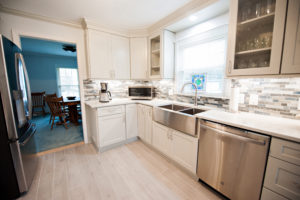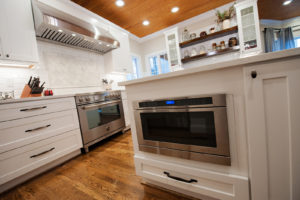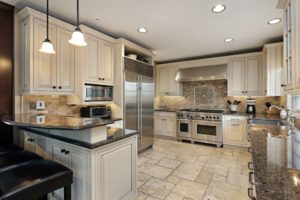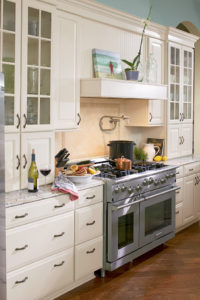
When it comes to kitchen remodeling, flooring is one of the most important decisions you’ll make. Your flooring sets the tone for the entire room and is one of the most heavily trafficked areas in your home. One question that often comes up when it comes to kitchen flooring is whether or not it should go under appliances. The answer is not straightforward and depends on a few factors.
In this blog post, we’ll explore the pros and cons of installing kitchen flooring under appliances and help you make an informed decision for your next kitchen renovation.
Pros of Installing Kitchen Flooring Under Appliances
 Seamless Look: One of the biggest advantages of installing kitchen flooring under appliances is that it creates a seamless look throughout the entire room. By installing flooring underneath your appliances, you’ll avoid any gaps or transitions that can be visually unappealing.
Seamless Look: One of the biggest advantages of installing kitchen flooring under appliances is that it creates a seamless look throughout the entire room. By installing flooring underneath your appliances, you’ll avoid any gaps or transitions that can be visually unappealing.- Protection: Another benefit of installing flooring under appliances is that it provides protection for your subfloor. Over time, appliances can leak or spill, causing damage to the subfloor. Having flooring installed under appliances can help to prevent this damage, and make it easier to clean up any spills that do occur.
- Stability: Large appliances like refrigerators and dishwashers are heavy, and they can move around over time. By installing flooring under these appliances, you can help to stabilize them and prevent them from shifting or moving.
- Resale Value: If you plan to sell your home in the future, having flooring installed under your appliances can be a selling point for potential buyers. It shows that you’ve taken care of your home and paid attention to important details.
Cons of Installing Kitchen Flooring Under Appliances
- Difficulty: One of the biggest disadvantages of installing flooring under appliances is the difficulty of installation. It can be challenging to install flooring under large appliances, and you may need to hire a professional to do the job. This can add to the overall cost of your renovation.
- Maintenance: While installing flooring under appliances can protect your subfloor from damage, it can also make maintenance more challenging. If you need to remove an appliance to make a repair, you’ll need to remove the flooring as well. This can be time-consuming and expensive.
- Cost: Installing flooring under appliances can add to the overall cost of your renovation. Not only will you need to purchase additional flooring, but you may also need to hire a professional to do the installation.
- Style: Depending on the style of your appliances, installing flooring underneath them may not be visually appealing. For example, if you have a large, stainless steel refrigerator, having flooring installed underneath it may create a jarring visual break.
 Things to Consider
Things to Consider
Ultimately, the decision to install flooring under appliances comes down to personal preference and practicality. If you value a seamless look and want to protect your subfloor from damage, installing flooring under appliances may be the best choice for you. However, if you’re concerned about the difficulty of installation or the added cost, you may want to skip this step.
If you do decide to install flooring under appliances, there are a few things to keep in mind.
Type of Flooring Material
First, make sure you choose a durable and water-resistant flooring material that can stand up to spills and leaks. Additionally, consider installing a moisture barrier underneath the flooring to provide an extra layer of protection for your subfloor.
Calling a Professional
When it comes to installation, it’s essential to hire a professional if you’re not confident in your ability to do the job yourself. A professional can ensure that the flooring is installed correctly and can help you avoid any damage to your appliances or subfloor.
 Creating a Cohesive Look
Creating a Cohesive Look
If you choose not to install flooring under appliances, there are still ways to create a cohesive look in your kitchen. You can use transition strips to create a smooth transition between the flooring and appliances. Additionally, you can choose a flooring material that complements your appliances, creating a cohesive design throughout the room.
Type of Appliance
It’s also important to consider the type of appliance you’re dealing with when making your decision. For example, a built-in range or oven may not require flooring to be installed underneath, as it’s not likely to move or shift over time. On the other hand, a large refrigerator or dishwasher may benefit from having flooring installed underneath, as these appliances are more prone to movement and potential leaks.
Another factor to consider is the age and condition of your appliances. If you’re planning to replace your appliances in the near future, it may not make sense to install flooring underneath them, as you’ll need to remove it when the time comes to replace the appliances.
Why Flooring Matters in Your Kitchen Remodel
When remodeling a kitchen, it’s easy to focus on countertops, cabinets, and appliances, but flooring is just as important. Not only does it set the overall style and feel of the room, but it also needs to handle the daily wear and tear of a busy household. Choosing the right flooring can enhance the functionality and beauty of your kitchen, making it a space you’ll love for years to come. Whether or not you choose to extend that flooring under your appliances can have a big impact on the outcome of your remodel.
Pros and Cons of Not Installing Flooring Under Appliances
Ease of Installation
One of the main advantages of not installing flooring under appliances is the easier installation process. Without having to fit the flooring under heavy appliances like the refrigerator or stove, the job can often be completed faster and with less hassle. This can save time and reduce the overall labor cost of your remodel, especially if you’re handling the installation yourself.
Easier Appliance Replacement
Not having flooring under your appliances can make it easier when the time comes to replace or move them. You won’t have to worry about damaging the floor during installation or struggling to lift the appliance to remove it from a tight space. Plus, this setup makes future maintenance simpler, as you can easily access the appliance without disturbing the surrounding flooring.
Is It Always Necessary to Install Flooring Under Appliances?
While installing flooring under appliances provides protection for your subfloor and offers a seamless look, it’s not always necessary for every kitchen. For instance, built-in appliances, like wall ovens or cooktops, often don’t need flooring underneath since they are more permanent fixtures. In contrast, movable appliances like refrigerators and dishwashers benefit from having flooring underneath to prevent movement and protect against potential leaks.
Flooring Materials and Water Resistance
No matter where you decide to place your kitchen flooring, choosing the right material is essential. Kitchens are high-traffic areas that are prone to spills, moisture, and heavy use, so it’s important to pick a durable and water-resistant material. Options like tile, luxury vinyl, or engineered wood are great choices for kitchens because they can stand up to the daily rigors of cooking and cleaning. Adding a moisture barrier beneath the flooring is also a good idea, especially in areas where leaks or spills may occur.
Alternatives to Flooring Under Appliances
If you decide against installing flooring under your appliances, there are still ways to create a polished look in your kitchen. Transition strips can be used to bridge the gap between the flooring and appliances, providing a smooth, finished edge. Additionally, consider choosing a flooring material and color that complements your appliances to tie the room together visually, even if the flooring doesn’t extend underneath every piece.
 Long Story Short
Long Story Short
In summary, the decision to install flooring under appliances comes down to personal preference and practicality. While there are benefits to having flooring installed underneath appliances, such as a seamless look and added protection for your subfloor, there are also drawbacks, such as added cost and difficulty of installation.
If you do decide to install flooring under appliances, be sure to choose a durable and water-resistant flooring material and consider hiring a professional to do the installation. And if you choose not to install flooring under appliances, there are still ways to create a cohesive design in your kitchen using transition strips and complementary flooring materials.
Bring Your Dream Kitchen to Life
Ultimately, the most important thing is to choose a flooring option that meets your needs and fits your personal style. By weighing the pros and cons of installing flooring under appliances and considering all factors, you can make an informed decision for your next kitchen renovation project.
If you are considering a kitchen remodel near the Greensboro, North Carolina area, contact Kitchen Express! As the Triad’s number one kitchen remodeling professionals, we have over twenty years of experience bringing peoples’ dream kitchens to life. We are with you every step of the way for the remodel, from your free in-home design consultation all the way until the first reveal of your newly remodeled kitchen. Give us a call today or fill out the form below to schedule your in-home design consultation, and let’s get started!
Contact Us Today
